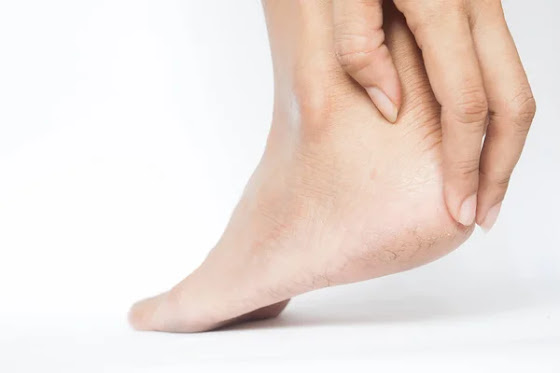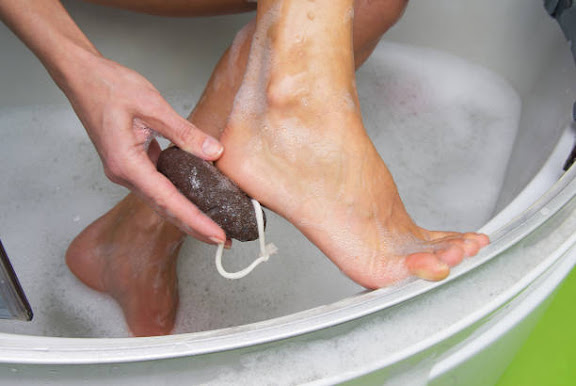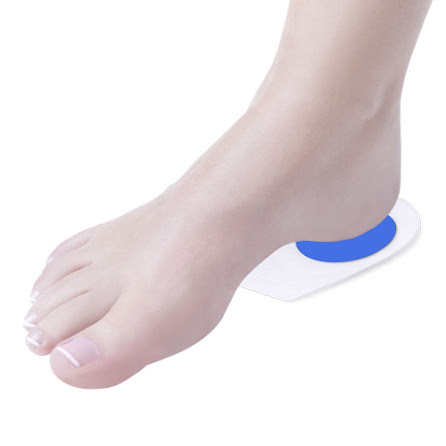How To Get Rid Of
Foot Cracks
Note: Friends, if you want to read this article in any other language, please change the language from the translate button at the top of this article.
 |
| Foot cracks are splits or cracks in the skin on the heels of the feet |
Foot cracks, also known as heel fissures, are splits or cracks in the skin on the heels of the feet. They are a common foot problem and can range from minor to severe.
Foot cracks are often caused by dry skin, which can be the result of a variety of factors, including genetics, weather, harsh soaps or detergents, standing for long periods, and wearing shoes that don't fit properly.
When the skin on the heel becomes too dry, it can lose its elasticity and become prone to cracking.
What Happens If Foot Cracks Are Left Untreated?
If left untreated, foot cracks can become painful and even bleed, increasing the risk of infection. Regular foot care, such as moisturizing and exfoliating, can help prevent and treat foot cracks.
Main causes of foot cracks
The main causes of foot cracks, or heel fissures, are:
Dry skin:
When the skin on your feet lacks moisture, it becomes dry, thick, and less elastic. This can lead to cracking, particularly around the heels, which have the thickest skin.
Standing for long periods:
If you stand for long periods of time, the pressure on your feet can cause dryness and thickening of the skin, leading to cracks.
Open-back shoes:
Shoes that expose the heels, such as sandals and flip-flops, can cause dryness and cracking of the skin, as they provide little or no support to the heel area.
Obesity:
People who are overweight or obese are more likely to develop foot cracks, as the pressure on their feet is greater.
Certain medical conditions:
Certain medical conditions, such as diabetes, hypothyroidism, and psoriasis, can cause dry skin and foot cracks.
Nutrient deficiencies:
Deficiencies in vitamins A, C, and E, as well as omega-3 fatty acids, can cause dry skin, making the feet more prone to cracking.
Aging:
As we age, the skin on our feet becomes thinner and less elastic, which can make it more prone to dryness and cracking.
Harsh soaps and detergents:
Using harsh soaps and detergents to clean the feet can strip the skin of its natural oils, leading to dryness and cracking.
By taking care of your feet and addressing these underlying causes, you can prevent and treat foot cracks.
Ways To Get Rid Of Foot Cracks
1. Regularly moisturizing your feet:
Moisturizing your feet with a good foot cream or lotion can help keep your skin hydrated and prevent cracks from forming.
It's important to moisturize your feet daily, especially after showering or bathing.
2. Exfoliating or scrubbing your feet:
 |
| Exfoliating your feet with a foot scrub or pumice stone can help remove dead skin cells |
Exfoliating your feet with a foot scrub or pumice stone can help remove dead skin cells and prevent the buildup of dry, rough skin that can lead to cracks.
3. Using a foot soak:
Soaking your feet in warm water with added Epsom salt or essential oils can help soften your skin and make it easier to remove dry, dead skin.
4. Wearing comfortable shoes:
Wearing comfortable shoes that fit properly can help prevent pressure on your heels, which can lead to cracks.
5. Using heel cushions:
Heel cushions can help redistribute pressure on your heels and provide extra cushioning to prevent cracks.
6. Seeking medical treatment:
If your foot cracks are severe or painful, it's important to seek medical treatment from a podiatrist or dermatologist. They may recommend prescription creams or ointments or other treatments, such as laser therapy.
Ayurvedic Home Remedies For Foot Cracks
Ayurveda, the ancient Indian system of medicine, offers several natural remedies for treating foot cracks.
Here are some Ayurvedic home remedies for foot cracks:
1. Apply coconut oil:
Coconut oil is a natural moisturizer that can help to soften and hydrate dry, cracked skin.
Apply warm coconut oil to your feet, focusing on the cracked areas, and leave it on overnight.
Repeat this treatment daily until your foot cracks have healed.
2. Use ghee:
Ghee, or clarified butter, is another effective moisturizer for dry, cracked skin.
Warm some ghee and apply it to your feet, focusing on the cracks. Leave it on for at least 30 minutes, then rinse it off with warm water. Repeat this treatment daily.
3. Make a foot soak:
Add a cup of oatmeal to a bucket of warm water and soak your feet for 15-20 minutes. Oatmeal is a natural skin softener that can help to soothe and heal foot cracks.
4. Apply aloe vera:
Aloe vera gel is a natural moisturizer that can help to soothe and heal cracked skin.
Apply fresh aloe vera gel to your feet and leave it on for 30 minutes, then rinse it off with warm water. Repeat this treatment twice a day.
5. Use turmeric:
Turmeric is a natural anti-inflammatory and antiseptic that can help to heal foot cracks and prevent infection.
Mix some turmeric powder with a little water to form a paste and apply it to your feet, focusing on the cracked areas.
Leave it on for 10-15 minutes, then rinse it off with warm water. Repeat this treatment once a day.
Frequently Asked Questions On Foot Cracks
Some frequently asked questions (FAQs) about foot cracks:
Q: What are foot cracks, and what causes them?
A: Foot cracks, or heel fissures, are splits or cracks in the skin on the heels of the feet.
They are often caused by dry skin, which can be the result of factors such as genetics, weather, standing for long periods, wearing open-back shoes, obesity, certain medical conditions, and harsh soaps and detergents.
Q: What are the symptoms of foot cracks?
A: The symptoms of foot cracks may include dry, thickened skin on the heels, flaky or scaly skin, redness, itching, and pain. In severe cases, foot cracks may bleed and become infected.
Q: How can I prevent foot cracks?
A: To prevent foot cracks, it's important to keep your feet clean and moisturized. Wear comfortable shoes that fit properly and provide support, and avoid standing for long periods.
You can also use a foot scrub or pumice stone to exfoliate your feet and remove dead skin.
Q: How are foot cracks treated?
A: Mild cases of foot cracks can be treated with home remedies such as moisturizing with coconut oil or ghee, using foot soaks, and applying aloe vera or turmeric.
For more severe cases, a podiatrist or dermatologist may recommend prescription creams or ointments or other treatments, such as laser therapy.
Q: When should I see a doctor for foot cracks?
A: If your foot cracks are severe, painful, or bleeding, or if you have signs of infection such as swelling, redness, or pus, you should see a doctor.
You should also see a doctor if your foot cracks are not improving with home remedies.
Q: Can foot cracks be contagious?
A: Foot cracks themselves are not contagious, but they can become infected with bacteria or fungi, which can be contagious.
It's important to keep your feet clean and dry and avoid sharing towels, shoes, or other personal items to prevent the spread of infection.
Q: Are there any risk factors for developing foot cracks?
A: Yes, there are several risk factors that can increase your likelihood of developing foot cracks.
These include being overweight or obese, having certain medical conditions such as diabetes or psoriasis, standing for long periods of time, wearing open-back shoes, and using harsh soaps and detergents.
Q: How can I choose the right moisturizer for foot cracks?
A: Look for a thick, emollient moisturizer that contains natural ingredients such as shea butter, coconut oil, or aloe vera.
Avoid moisturizers that contain alcohol or fragrances, which can be drying to the skin. You can also use petroleum jelly or a hydrating foot cream specifically designed for foot cracks.
Q: Can foot cracks be prevented with a healthy diet?
A: Yes, maintaining a healthy diet that is rich in vitamins and minerals can help to prevent foot cracks.
Foods that are high in omega-3 fatty acids, such as fish and nuts, can help to nourish the skin, while foods that are high in vitamins A, C, and E can help to promote skin health.
Q: Can I use essential oils to treat foot cracks?
A: Yes, some essential oils, such as lavender and tea tree oil, have antimicrobial and anti-inflammatory properties that can help to soothe and heal foot cracks.
However, it's important to dilute essential oils before applying them to the skin, as they can be irritating or even cause an allergic reaction in some people. Always do a patch test before using any new essential oils
Friends, Stay Fit, Stay Happy
--------------------------------------------------------
Friends, if you liked it, please share it with your friends.
SHARING IS CARING.
Compiled by: Paramjit Singh Rana



Comments
Post a Comment